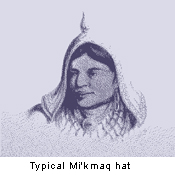The Mi'kmaq were the major indigenous group occupying
the Maritimes at the time of European contact. They
were part of the Algonquian language group (the two
main language
groups of the
Northeastern
indigenous peoples
were the Algonquian
and the
Iroquoian),
although they had
their own distinctive
dialect.  Close
neighbours of the
Mi'kmaq were the
Malecite (also spelled Maliseet). They
lived mostly in the
western part of
what is now New Brunswick. While the Mi'kmaq were
coastal people, the Malecite depended more on inland
resources and even cultivated corn. We know less about
the Malecite because the early European settlers and
explorers had little contact with them.
Close
neighbours of the
Mi'kmaq were the
Malecite (also spelled Maliseet). They
lived mostly in the
western part of
what is now New Brunswick. While the Mi'kmaq were
coastal people, the Malecite depended more on inland
resources and even cultivated corn. We know less about
the Malecite because the early European settlers and
explorers had little contact with them.
FOOD AND ECONOMY
Hunting and fishing were the main activities of the Mi'kmaq. In winter they would camp in smaller family groups and hunt for deer, elk, seal, beaver, otter, moose, bear and caribou. In the spring and summer they joined with other families to form larger camps. They gathered and boiled maple tree sap in the spring and did a little farming in the summer, but their main food source at this time of year was fish - smelts, herring, sturgeon, salmon, cod and eels.
DWELLINGS
The Mi'kmaq built birchbark-covered wigwams which were light and easy to roll up and carry to a new location. Sometimes wigwams were round with a single fire in the middle. These accommodated 10 to 12 people. Larger wigwams were long with a fire at each end and room for 20 to 24 people.
TRANSPORTATION
The Mi'kmaq had birchbark canoes that could hold five or six people. In the 17th century they added sails to these canoes. In winter they travelled through the snow with the aid of snowshoes, sleds and toboggans. In fact, our word "toboggan" comes from the Mi'kmaq "taba'gan."
SOCIAL ORGANIZATION
The Mi'kmaq had no central governing authority like the Haudenosaunee. There were seven traditional political districts, each headed by its own chief or sagamore. A Grand Chief located in the head district of Cape Breton Island hosted periodic council meetings attended by the band chiefs. The Mi'kmaq were also part of the Wabenaki Confederacy, a loose alliance of several indigenous groups from the northeastern region who met once every few years, sometimes as far away as present-day Boston.
CLOTHING & UTENSILS
 Men wore loincloths in the
summer and fur robes with leggings and moccasins in
winter. Women wore similar robes or long tunics made
from skins which were decorated with paint and porcupine
quills. In the 18th century they began to wear
pointed hats. Most of their domestic tools were made
from lightweight birchbark, often elaborately decorated
with porcupine quills. These quilled boxes and baskets
are quite distinctive to the Mi'kmaq and Malecite.
Men wore loincloths in the
summer and fur robes with leggings and moccasins in
winter. Women wore similar robes or long tunics made
from skins which were decorated with paint and porcupine
quills. In the 18th century they began to wear
pointed hats. Most of their domestic tools were made
from lightweight birchbark, often elaborately decorated
with porcupine quills. These quilled boxes and baskets
are quite distinctive to the Mi'kmaq and Malecite.
RELIGION & FESTIVALS
The Mi'kmaq shared with other Algonquian nations a belief in a supreme being. There were also a number of
lesser gods, some in human form. One of the best
known is Glooscap who was more of a cultural hero than
a god, a human-like being with superhuman abilities.
Shamans shaman: a medicine man in
North American indigenous culture.
Someone with special spiritual
gifts and the ability to heal. could intercede between gods and humans to
cure the sick, predict the future, or help in warfare or the
hunt. The Mi'kmaq held big feasts to celebrate marriages,
funerals, and the beginning of the hunting season.
Elders would give speeches that told family stories and
kept their history alive. The Mi'kmaq chief, Membertou,
converted to Catholicism in 1610 and the Mi'kmaq
remained among the most firmly converted of the indigenous
peoples.
EUROPEAN CONTACT
European contact changed the economy of the Mi'kmaq, bringing them European goods like knives and different foods, most of which were not as healthy for them as their traditional diet. A lot of native people were killed off by European diseases like smallpox. The Mi'kmaq helped the Acadians settle in to their new life. They shared their hunting and fishing techniques with them, told them where to find local resources, showed them how to make clothes and canoes and how to insulate their houses against the winter. The Acadians had fairly good relations with the Mi'kmaq, but they participated, along with the English, when Governor Cornwallis offered a bounty for the dead body of any Mi'kmaq man, woman or child.
